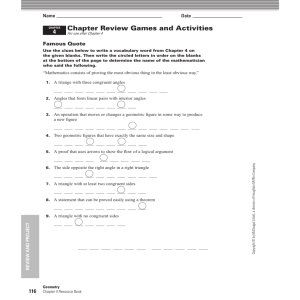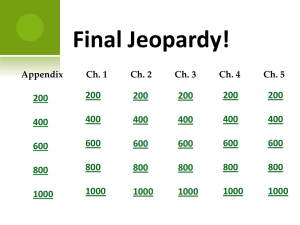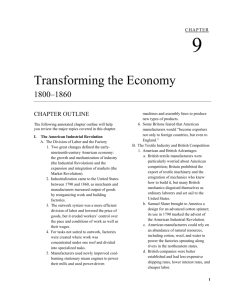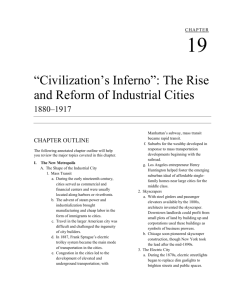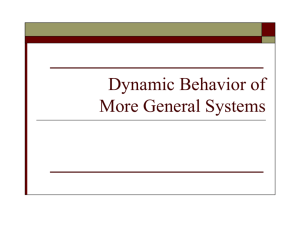H s
advertisement
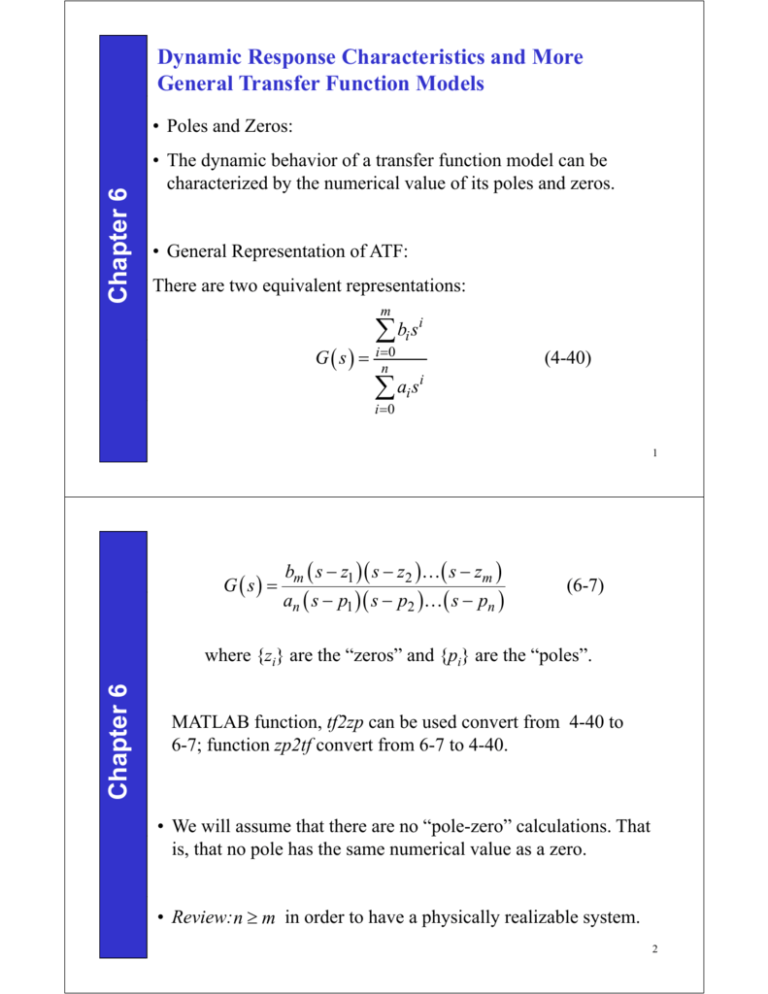
Dynamic Response Characteristics and More
General Transfer Function Models
Ch
hapter 6
• Poles and Zeros:
• Th
The dynamic
d
i behavior
b h i off a transfer
t
f function
f ti model
d l can be
b
characterized by the numerical value of its poles and zeros.
• General Representation of ATF:
There
h are two equivalent
i l representations:
i
m
G (s) =
∑ bi si
i =0
n
(4-40)
∑ ai si
i=0
1
G (s) =
bm ( s − z1 )( s − z2 )K( s − zm )
an ( s − p1 )( s − p2 )K ( s − pn )
((6-7))
Ch
hapter 6
where {z
{ i} are the “zeros” and {pi} are the “poles”.
“poles”
MATLAB function, tf2zp can be used convert from 4-40 to
6-7; function zp2tf convert from 6-7 to 4-40.
• We will assume that there are no “pole-zero”
p
calculations. That
is, that no pole has the same numerical value as a zero.
• Review: n ≥ m in order to have a physically realizable system.
2
Example 6.2
For the case of a single zero in an overdamped second
second-order
order
transfer function,
Ch
hapter 6
G (s) =
K ( τ a s + 1)
( τ1s + 1)( τ 2 s + 1)
(6-14)
calculate the response to the step input of magnitude M and plot
the results qualitatively.
Solution
The response of this system to a step change in input is
⎛ τ −τ
⎞
τ −τ
y ( t ) = KM ⎜1 + a 1 e−t / τ1 + a 2 e−t / τ 2 ⎟
τ 2 − τ1
⎝ τ1 − τ 2
⎠
(6-15)
3
Ch
hapter 6
Note that y ( t → ∞ ) = KM as expected; hence, the effect of
including the single zero does not change the final value nor does
it change the number or location of the response modes. But the
zero does affect how the response modes (exponential terms) are
weighted
eighted in the solution,
sol tion Eq.
Eq 6-15.
6 15
A certain amount of mathematical analysis (see Exercises 6.4, 6.5,
and 6.6) will show that there are three types of responses involved
here:
Case a:
τ a > τ1
Case b:
0 < τ a ≤ τ1
Case c:
τa < 0
4
Ch
hapter 6
5
Summary: Effects of Pole and Zero Locations
1 Poles
1.
Ch
hapter 6
• Pole in “right half plane (RHP)”: results in unstable system
(i.e., unstable step responses)
Imaginary axis
x
p = a + bjj
(j=
−1
)
x
x = unstable pole
Real axis
x
• Complex pole: results in oscillatory responses
I
Imaginary
i
axis
i
x
x = complex poles
Real axis
x
6
• Pole at the origin (1/s term in TF model): results in an
“integrating process”
Ch
hapter 6
2. Zeros
Note: Zeros have no effect on system stability
stability.
• Zero in RHP: results in an inverse response to a step change in
p
the input
Imaginary axis
x
R l
Real
axis
⇒ y
inverse
response
0
t
• Zero in left half plane: may result in “overshoot” during a step
response (see Fig. 6.3).
7
Ch
hapter 6
Pole location and response
8
Ch
hapter 6
Inverse Response Due to Two Competing Effects
Drum boiler:
• Cold water feed rate increases Æ Temp drop in the water Æ reduce the bubble
Æ reduce water level
•
With Q = constant, steam production = constant, additional flow rate Buildup h.
•
Two effects opposing each other.
An inverse response, τ a < 0 , occurs for two 1st order in parallel, if: (see page 135)
−
K2 τ2
>
K1 τ1
(6-22)
9
Show that the step response of any process described by
k (τ a s + 1)
(τ 1s + 1)(τ 2 s + 1)
will have an inverse response to a step change of magnitude of M, if and
only if: KM > 0, τ a < 0
G( s) =
Ch
hapter 6
Proof:
Inverse response corresponds to an initial negative slop, if KM >0
Y ( s)=
L[
k (τ a s + 1)
M
⋅
(τ 1 s + 1)(τ 2 s + 1) s
dy (t )
] = s ⋅ Y ( s)
d
dt
dy (t )
dt
= lim s ⋅ [ sY ( s)]
s→∞
t =0
K (τ a s + 1)
M
⋅
(τ1 s + 1)(τ 2 s + 1) s
K (τ a s + 1) sM
= lim
s→∞ (τ s + 1)(τ s + 1)
1
2
= lim s 2
s→∞
=
KMτ a
τ 1τ 2
<0
10
Time Delays (continued)
Transfer Function Representation:
Ch
hapter 6
Y (s)
U (s)
= e − θs
(6-28)
Note that θ has units of time (e.g.,
(e g minutes,
minutes hours)
11
Polynomial Approximations to e−θs :
Ch
hapter 6
For purposes off analysis
F
l i using
i analytical
l ti l solutions
l ti
to
t transfer
t
f
−θs
functions, polynomial approximations for e are commonly
used. Example: simulation software such as MATLAB and
MatrixX.
Two widely used approximations are:
1. Taylor
y Series Expansion:
p
e
− θs
θ 2 s 2 θ3 s 3 θ 4 s 4
= 1 − θs +
−
+
+K
2!
3!
4!
(6-34)
The approximation is obtained by truncating after only a few
terms.
12
2. Padé Approximations:
Many are available
available. For example,
example the 1/1 approximation is,
is
Ch
hapter 6
e − θs
θ
1− s
2
≈
θ
1+ s
2
(6 35)
(6-35)
Implications for Control:
Time delays are very bad for control because they involve a
delay of information.
13
Ch
hapter 6
Approximation of Higher-Order Transfer
Functions
In this section, we present a general approach for
approximating
i i high-order
hi h d transfer
f function
f
i models
d l with
ih
lower-order models that have similar dynamic and steady-state
characteristics.
In Eq
Eq. 6-4 we showed that the transfer function for a time
delay can be expressed as a Taylor series expansion. For small
values of s,
e −θ0 s ≈ 1 − θ 0 s
((6-57))
14
Ch
hapter 6
• An alternative first-order approximation consists of the transfer
function,
1
e −θ0 s =
e
θ0 s
≈
1
1 + θ0 s
(6-58)
where the time constant has a value of θ0 .
• Equations 6-57 and 6-58 were derived to approximate timedelay terms.
• However, these expressions can also be used to approximate
the pole or zero term on the right-hand side of the equation by
the time-delay
y term on the left side.
15
Skogestad’s “half rule”
Ch
hapter 6
• Skogestad (2002) has proposed a related approximation method
for higher-order models that contain multiple time constants.
• He approximates the largest neglected time constant in the
following manner.
• One half of its value is added to the existing time delay (if any)
and the other half is added to the smallest retained time constant.
• Time
i constants that
h are smaller
ll than
h the
h “largest
l
neglected
l
d time
i
constant” are approximated as time delays using (6-58).
16
Example 6.4
Consider a transfer function:
Ch
hapter 6
G (s) =
K ( −0.1s + 1)
( 5s + 1)( 3s + 1)( 0.5s + 1)
(6-59)
(6
59)
Derive an approximate first-order-plus-time-delay model,
Ke−θs
%
G (s) =
τs + 1
using two methods:
(6-60)
(a) The Taylor series expansions of Eqs
Eqs. 66-57
57 and 66-58.
58
(b) Skogestad’s half rule
Compare the normalized responses of G(s) and the approximate
models for a unit step input.
17
Solution
( ) Th
(a)
The dominant
d i t time
ti constant
t t (5) is
i retained.
t i d Applying
A l i
the approximations in (6-57) and (6-58) gives:
Ch
hapter 6
−0.1s + 1 ≈ e −0.1s
(6-61)
and
1
≈ e −3s
3s + 1
1
≈ e−0.5 s
0.5s + 1
(6-62)
Substitution into (6-59) gives the Taylor series
approximation, G%TS ( s ) :
Ke −0.1s e−3s e−0.5 s Ke−3.6 s
%
GTS ( s ) =
=
5s + 1
5s + 1
(6-63)
18
Ch
hapter 6
(b) To use Skogestad’s method, we note that the largest neglected
time constant in (6-59) has a value of three.
• According to his “half rule”, half of this value is added to the
next largest time constant to generate a new time constant
τ = 5 + 0.5(3) = 6.5.
• The other half provides a new time delay of 0.5(3) = 1.5.
• The approximation
pp
of the RHP zero in ((6-61)) pprovides an
additional time delay of 0.1.
• Approximating the smallest time constant of 0.5 in (6-59) by
(6 58) produces an additional time delay of 0.5.
(6-58)
05
• Thus the total time delay in (6-60) is,
θ = 1.5 + 0.1 + 0.5 = 2.1
19
and G(s) can be approximated as:
Ch
hapter 6
2.1ss
Ke −2.1
K
%
GSk ( s ) =
6.5s + 1
(6-64)
The normalized step responses for G(s) and the two approximate
models are shown in Fig. 6.10. Skogestad’s method provides
better agreement with the actual response.
response
Figure 6.10
C
Comparison
i
off the
th
actual and
approximate models
for Example 6.4.
20
Example 6.5
Consider the following transfer function:
Ch
hapter 6
G (s) =
K (1 − s ) e− s
0 2 s + 1)( 00.05
05s + 1)
(12s + 1)( 3s + 1)( 0.2
(6-65)
Use Skogestad’s method to derive two approximate models:
(a) A first-order-plus-time-delay model in the form of (6-60)
((b)) A second-order-plus-time-delay
p
y model in the form:
G% ( s ) =
Ke −θs
( τ1s + 1)( τ 2 s + 1)
(6-66)
Compare
p the normalized output
p responses
p
for G(s)
( ) and the
approximate models to a unit step input.
21
Solution
Ch
hapter 6
(a) For the first-order-plus-time-delay
first order plus time delay model,
model the dominant time
constant (12) is retained.
• One-half of the largest neglected time constant (3) is allocated to
the retained time constant and one-half to the approximate time
delay.
• Also, the small time constants (0.2 and 0.05) and the zero (1) are
added to the original time delay.
• Thus the model parameters in (6-60) are:
3.0
+ 0.2
0 2 + 00.05
05 + 1 = 33.75
75
2
3.0
τ = 12 +
= 13.5
2
θ = 1+
22
(b) An analogous derivation for the second-order-plus-time-delay
model gives:
0.2
+ 00.05
05 + 1 = 22.15
15
2
τ1 = 12,
τ 2 = 3 + 0.1 = 3.1
Ch
hapter 6
θ = 1+
In this case, the half rule is applied to the third largest time
constant (0.2). The normalized step responses of the original and
approximate transfer functions are shown in Fig. 6.11 of next slide.
Ch
hapter 6
23
Figure 6.11 Comparison of the actual model and approximate models of
Example 6.5
24
Interacting vs. Noninteracting Systems
• Consider a process with several invariables and several output
variables. The process is said to be interacting if:
o Each input affects more than one output.
output
Ch
hapter 6
or
o A change in one output affects the other outputs.
Otherwise, the process is called noninteracting.
• As an example, we will consider the two liquid-level storage
systems shown in Figs. 4.3 and 6.13.
• In general, transfer functions for interacting processes are more
complicated than those for noninteracting processes.
25
Ch
hapter 6
Figure 4.3. A noninteracting system:
two surge tanks in series.
Fi
Figure
6.13.
6 13 Two
T tanks
t k in
i series
i whose
h
liquid
li id levels
l l interact.
i t
t
26
Ch
hapter 6
Figure 44.3.
Fi
3 A noninteracting
i t
ti system:
t
two surge tanks in series.
dh1
= qi − q1
dt
Mass Balance:
A1
Valve Relation:
q1 =
1
h1
R1
(4-48)
(4-49)
Substituting (4-49) into (4-48) eliminates q1:
A1
dh1
1
= qi − h1
dt
R1
(4-50)
27
Putting (4-49) and (4-50) into deviation variable form gives
A1
dh1′
1
= qi′ − h1′
dt
R1
Ch
hapter 6
q1′ =
1
h1′
R1
(4-51)
(4-52)
The transfer
Th
t
f function
f ti relating
l ti H1′ ( s ) to
t Q1i′ ( s ) is
i found
f d by
b
transforming (4-51) and rearranging to obtain
H1′ ( s )
R1
K1
=
=
Qi′ ( s ) A1R1s + 1 τ1s + 1
(4-53)
where K1 R1 and τ1 A1R1. Similarly, the transfer function
relating Q1′ ( s ) to H1′ ( s ) is obtained by transforming (4-52).
(4 52)
28
Ch
hapter 6
Q1′ ( s ) 1
1
=
=
H1′ ( s ) R1 K1
(4-54)
The same procedure leads to the corresponding transfer functions
for Tank 2,
2
H 2′ ( s )
R2
K2
=
=
(4-55)
Q2′ ( s ) A2 R2 s + 1 τ 2 s + 1
Q2′ ( s )
1
1
=
=
H 2′ ( s ) R2 K 2
(4 56)
(4-56)
where
h K 2 R2 andd τ 2 A2 R2. Note
N t that
th t the
th desired
d i d transfer
t
f
function relating the outflow from Tank 2 to the inflow to Tank 1
can be derived by forming the product of (4-53) through (4-56).
29
Q2′ ( s ) Q2′ ( s ) H 2′ ( s ) Q1′ ( s ) H1′ ( s )
=
Qi′ ( s ) H 2′ ( s ) Q1′ ( s ) H1′ ( s ) Qi′ ( s )
(4-57)
Q2′ ( s )
1 K 2 1 K1
=
Qi′ ( s ) K 2 τ 2 s + 1 K1 τ1s + 1
(4-58)
Ch
hapter 6
or
which can be simplified to yield
Q2′ ( s )
1
=
Qi′ ( s ) ( τ1s + 1)( τ 2 s + 1)
(4-59)
a second-order transfer function (does unity gain make sense on
physical grounds?)
grounds?). Figure 4.4
4 4 is a block diagram showing
information flow for this system.
30
Block Diagram for Noninteracting
Surge Tank System
Figure 4.4. Input-output model for two liquid surge tanks in
series.
31
Ch
hapter 6
Dynamic Model of An Interacting Process
Figure 6.13. Two tanks in series whose liquid levels interact.
q1 =
1
( h1 − h2 )
R1
(6-70)
The transfer functions for the interacting system are:
32
H 2′ ( s )
R
= 2 2 2
Qi′ ( s ) τ s + 2ζτs + 1
(6-74)
Ch
hapter 6
Q2′ ( s )
1
= 2 2
Qi′ ( s ) τ s + 2ζτ
2ζ s + 1
H1′ ( s )
K ′ ( τ s + 1)
= 2 12 a
Qi′ ( s ) τ s + 2ζτs + 1
(6-72)
where
τ= τ1τ 2 , ζ
τ1 + τ 2 + R2 A1
, and τ a
2 τ1τ 2
R1R2 A2 / ( R1 + R2 )
In Exercise 6.15, the reader can show that ζ>1 by analyzing the
denominator of (6-71);
(6 71); hence,
hence the transfer function is
overdamped, second order, and has a negative zero.
33
Model Comparison
• Noninteracting system
Q 2′ ( s )
1
=
Qi′ ( s ) ( τ1 s + 1)( τ 2 s + 1)
where τ1
A1 R1 and τ 2
(4-59)
A2 R 2 .
• Interacting system
Q 2′ ( s )
1
= 2 2
Qi′ ( s ) τ s + 2ζτ s + 1
where ζ > 1 and τ
τ1 τ 2
• General Conclusions
1. The interacting system has a slower response.
(Example: consider the special case where τ = τ1= τ2.)
2. Which two-tank system provides the best damping
of inlet flow disturbances?
34
Multiple-Input, Multiple Output
(MIMO) Processes
Ch
hapter 6
• Most industrial process control applications involved a number
of input (manipulated) and output (controlled) variables.
• These applications often are referred to as multiple-input/
multiple-output
li l
(
(MIMO)
) systems to di
distinguish
i i h them
h from
f
the
h
simpler single-input/single-output (SISO) systems that have
been emphasized
p
so far.
• Modeling MIMO processes is no different conceptually than
modeling SISO processes.
35
Ch
hapter 6
Example, consider the system illustrated below:
Assume:
(1) Liquid properties remain constant
(2) Perfect mixing
(3) wh and wc are manipulated for
controlling h and T
(4) Tc and Th are varying
(5) w is constant
Energy balance:
d ⎡V (T − Tref ) ⎤⎦
ρC ⎣
= whC (Th − Tref ) + wcC (Tc − Tref ) − wC (T − Tref )
dt
Mass balance:
ρ
dV
= wh + wc − w
dt
Expand the energy equation and introduce the mass balance into it, resulting the
Following two equation for the process
1
⎧ dT
⎪⎪ dt = ρ Ah [ whTh + wcTc − ( wh + wc )T ]
⎨
⎪ dh = 1 ( wh + wc − w)
⎪⎩ dt ρ A
36
Subtracting the above equations by the steady state equations, introducing
deviation variables, linearzing the equations, taking Laplace transform, and
performing proper arrangement
arrangement, resulting in:
_
_
−
_
_
−
_
−
_
−
(T h − T ) / w '
(T c − T ) / w '
w /w
w /w
T ( s) =
w h ( s) +
w c ( s) + h T 'h ( s) + c T 'c ( s)
τ s +1
τ s +1
τ s +1
τs +1
1/ Aρ '
1/ Aρ '
H ' ( s) =
w h ( s) +
w c ( s)
s
s
Ch
hapter 6
'
A compact way to express the above model is to introduce matrix representation:
_
−
⎛ _
(
T
h−T)/ w
⎡T ' ( s ) ⎤ ⎜
⎢ ' ⎥ = ⎜ τ s +1
⎣ H ( s ) ⎦ ⎜ 1/ Aρ
⎜
s
⎝
_
_
−
⎞
_
−
(T c − T ) / w ⎟ '
⎛ _ −
⎞ '
w
/
w
w
/
w
⎡ w h ( s)⎤ ⎜ h
c
⎟ ⎡T h ( s ) ⎤
τ s +1 ⎟ ⎢
⎥ + ⎜τ s +1 τ s +1⎟ ⎢ '
⎥
'
⎢⎣T c ( s ) ⎥⎦
1/ Aρ ⎟ ⎢⎣ w c ( s ) ⎥⎦ ⎜
⎟
0 ⎠
⎟
⎝ 0
s
⎠
Controlled variables, output
p
variables
Manipulated
Load (disturbance) variables
Interaction exists, why?
Ch
hapter 6
37
38

